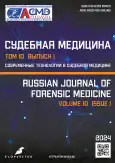Use of an underwater drone during the study of drowned bodies: a review
- Authors: Zhantureyev Z.Z.1, Begaliyev Y.N.1, Aubakirova A.A.2, Bertleuov S.S.1
-
Affiliations:
- Academy of Law Enforcement Agencies Under the General Prosecutors Office of the Republic of Kazakhstan
- St. Petersburg University of Humanities and Social Sciences
- Issue: Vol 10, No 1 (2024)
- Pages: 68-78
- Section: Reviews
- URL: https://journals.rcsi.science/2411-8729/article/view/254428
- DOI: https://doi.org/10.17816/fm16097
- ID: 254428
Cite item
Abstract
This article describes the effectiveness of an unmanned underwater vehicle (underwater drone) in searching for drowned people in reservoirs and the impact of an underwater drone on the production of forensic medical examination in drowning.
The article considers the norms of legislation that regulate the procedure for using an underwater drone in the criminalistic support of crime investigations.
This study considered the norms of legislation that regulate the use of scientific and technical means in criminology and scientific publications of researchers in the field of forensic medical examination. A SWOT analysis of the use of an underwater drone to improve the quality of crime investigation was performed. The results of the study revealed the positive and negative aspects of the use of an underwater drone in investigations.
Based on the results of generalization of scientific papers and analysis of the use of scientific and technical means in the activities of law enforcement agencies in foreign countries, the use of an underwater drone for examining corpses in water was proposed. An underwater drone can reach places inaccessible to humans and help identify key details of the crime. During investigation of drowning crimes, underwater drones enables the analysis of the condition of the victim’s body without bringing it to the surface, which facilitates further investigation.
Keywords
Full Text
##article.viewOnOriginalSite##About the authors
Zhandos Z. Zhantureyev
Academy of Law Enforcement Agencies Under the General Prosecutors Office of the Republic of Kazakhstan
Author for correspondence.
Email: zh_zh_zh@list.ru
ORCID iD: 0000-0001-9413-6328
SPIN-code: 1371-2330
Kazakhstan, Koshy
Yernar N. Begaliyev
Academy of Law Enforcement Agencies Under the General Prosecutors Office of the Republic of Kazakhstan
Email: ernar-begaliev@mail.ru
ORCID iD: 0000-0001-6659-8576
SPIN-code: 1929-3392
Dr. Sci. (Legal), Professor
Kazakhstan, KoshyAnna A. Aubakirova
St. Petersburg University of Humanities and Social Sciences
Email: anna_lir@mail.ru
ORCID iD: 0000-0002-6547-0869
SPIN-code: 3074-7383
Dr. Sci. (Legal), Professor
Russian Federation, Saint PetersburgSaken S. Bertleuov
Academy of Law Enforcement Agencies Under the General Prosecutors Office of the Republic of Kazakhstan
Email: saken1989ber@mail.ru
ORCID iD: 0000-0002-2068-6148
SPIN-code: 7645-7760
Kazakhstan, Koshy
References
- Selivanov NA. Reference book of a criminalist. Moscow: Norma; 2000. P. 501. (In Russ).
- Orakbayev AB, Kurmangali ZhK, Begaliyev YeN, et al. ON The issue of using the results of a virtual autopsy in criminal investigation: A review. Russ J Forensic Med. 2023;9(2):183-192. EDN: OEERGD doi: https://doi.org/10.17816/fm774
- Armstrong EJ, Erskine KL. Investigation of drowning deaths: A practical review. Acad Forensic Pathol. 2018;8(1):8-43. doi: 10.23907/2018.002
- Os'minkin VA. On the problem of microscopic diagnostics of death by drowning. Forensic medical expertise. 2013;56(1):39-41. EDN: QAZNIH
- Prilutsky SA. About death in water. Forensic medical expertise. 1963;(2):24-27. (In Russ).
- Pigolkin YI, Dubrovin IA. Forensic medicine. Textbook. Moscow: Meditsinskoe informatsionnoe agentstvo; 2015. Р. 219. (In Russ).
- Firsov AS, Kalinina YeYu. Drowning diagnosis: Evolution of approaches and modern methods. Sovremennyye problemy nauki i obrazovaniya. 2015;(3):144. EDN: TYSIOL
- Haglund WD, Sorg MH. Advances in forensic taphonomy: Method, theory, and archeological perspectives. CRC Press (Boca Raton, London); 2002. doi: 10.1201/9781420058352
- Voyevodkin DV, Rustemova GR, Begaliyev YN, et al. Identifying fake conclusions of forensic medical examinations using an artificial intelligence technology based on the experience in the Republic of Kazakhstan: A review. Russ J Forensic Med. 2023;9(3):287-298. EDN: EFNJIE doi: 10.17816/fm8270
- Paba R, Moniz R, Magni PA. Optimizing underwater visual records for crime scene investigations in water with clear to reduced visibility. Forensic Sci Int Synerg. 2023;6:100329. doi: 10.1016/j.fsisyn.2023.100329
- Korenevsky YV. Criminalistics for judicial investigation. Moscow; 2001. Р. 24. (In Russ).
Supplementary files








